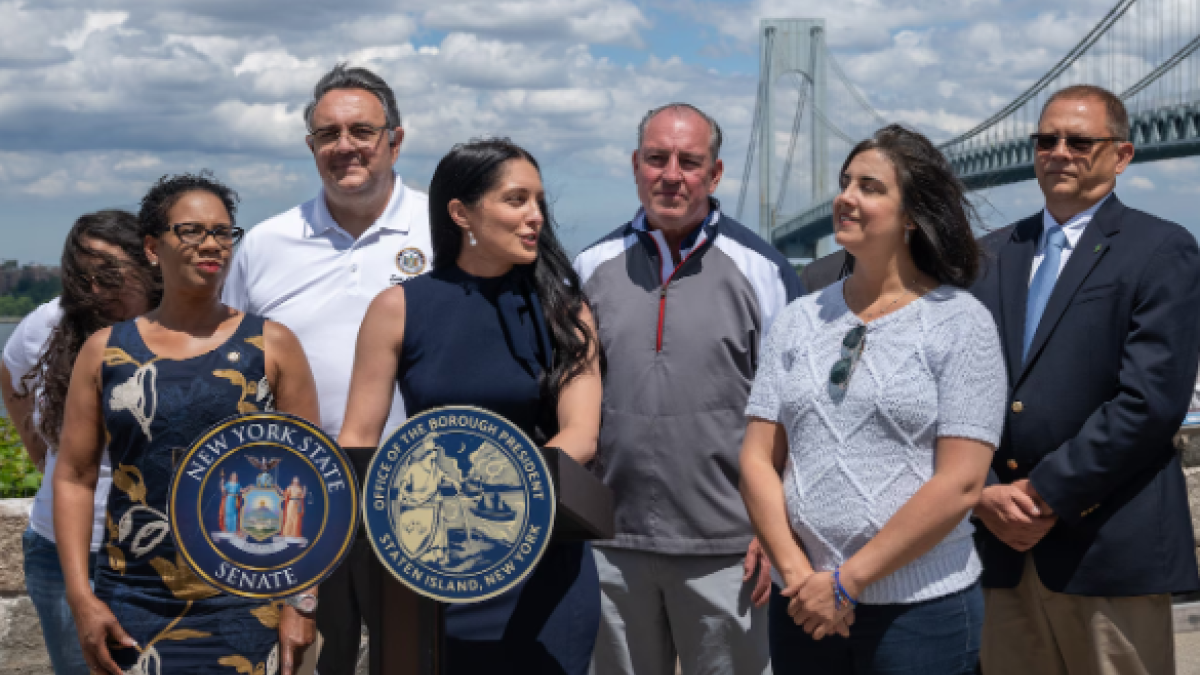Staten Island electeds unite on defeating congestion pricing: ‘We want this thing dead’

STATEN ISLAND, N.Y. — From across both the aisle and the borough, Staten Island’s political representation celebrated the sudden stoppage of congestion pricing on Sunday.
Overlooking both the Verrazzano-Narrows Bridge and Battery Weed in Fort Wadsworth, the press conference featured State Sen. Jessica Scarcella-Spanton (D-North Shore/South Brooklyn), Borough President Vito Fossella, Rep. Nicole Malliotakis (R-Staten Island/South Brooklyn), Councilmember Kamillah Hanks (D-North Shore), Assemblymember Sam Pirozzolo (R-Mid-Island), along with representatives from Assemblymember Michael Tannousis (R-East Shore/South Brooklyn), Assemblymember Michael Reilly (R-South Shore), District Attorney Michael E. McMahon, and the United Federation of Teachers.
The lawmakers came together in response to Gov. Kathy Hochul’s decision to stop congestion pricing, which would’ve charge vehicles a variable fee — as much as $15 — when entering the Congestion Relief Zone (CRZ), before the June 30 start date.
“This is not a Democrat or Republican issue, this is an issues that would negatively impact Staten Islanders,” said Scarcella-Spanton. “And that’s what we always do. We come together unified to say this is the wrong plan.”
“We need to press upon the Governor that we want those words ‘indefinitely postponed’ to be ‘permanently postponed.’ We want this thing dead,” said Malliotakis, who also echoed the statement of unity.
Many of the legislators at the conference, including Fossella, Malliotakis, and Scarcella-Spanton, are part of a joint lawsuit with the United Federation of Teachers against congestion pricing.
The suit, which is publicly available online, claims that congestion pricing “would not eliminate air and noise pollution and traffic, but would simply shift pollution and traffic to Staten Island, the Bronx, Upper Manhattan, and Northern New Jersey.”
The project’s environmental assessment noted that congestion pricing will likely result in additional traffic and pollution on Staten Island as vehicles try to avoid the new toll.
“The MTA’s own environmental impact study showed that air pollution would get worse on the North Shore of Staten Island, where we already have extremely high rates of asthma and a high rate of cancer,” said Scarcella-Spanton. “We cannot in good faith support a policy that places one borough over another in terms of congestion and pollutants.”
In addition to environmental issues, concerns arose about the current subway and bus systems’ ability to handle a surge in ridership that June 30 would’ve brought.
“The current infrastructure is ill equipped to handle the surge in ridership. It is particularly concerning that the MTA has not decided to increase routes or capacity in the North Shore’s express buses,” said Hanks, who earlier this year called congestion pricing “borough discrimination.”
Under the congestion pricing plan, the MTA would’ve only increased bus service during peak periods on four lines, the SIM1C, SIM4C, SIM23 and SIM24.
In response to reports that the MTA would now be facing a $1 billion budget gap, the elected officials voiced a belief that a crackdown on farebeaters, along with an infusion of federal money, should backstop any funding issues.
“We have people who don’t pay their tolls, we have people who don’t pay their fare. What ever happened to ‘pay your fare share?’” said Pirozzolo. “Just on that alone, we have three-quarters of the amount of money we need to make sure that congestion pricing doesn’t come back.”
“It is clear from the Governor’s decision that she has recognized the unpopularity of this program. Any conversation regarding funding for the MTA should start with the over $700 million that the MTA loses to toll and fare evasion every year,” echoed Tannousis in a statement.
As a next step, some in attendance said that the next fight, along with continuing the ongoing lawsuits, would be to get the congestion pricing infrastructure in Manhattan removed.
“They still have the overhead scanners throughout Manhattan, but they wasted a half a billion dollars on them,” said Fossella. “So what we’re calling for, frankly, is to take those things down today. If you want to allay any concerns or fears that this thing may rear its head again, I think one way you can do it, the city, the state, the MTA, whoever’s involved, take those scanners down.”